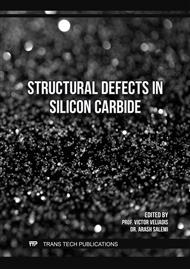[1]
Victor Veliadis. "SiC Mass Commercialization: Present Status and Barriers to Overcome". In: Materials Science Forum 1062 (2022), p.125–130.
DOI: 10.4028/p-6zcw3b
Google Scholar
[2]
Tsunenobu Kimoto and James A. Cooper. Fundamentals of silicon carbide technology: Growth, characterization, devices and applications. Singapore: John Wiley & Sons Singapore Pte. Ltd, 2014.
DOI: 10.1002/9781118313534
Google Scholar
[3]
Peder Bergman et al. "Crystal Defects as Source of Anomalous Forward Voltage Increase of 4H-SiC Diodes". In: Materials Science Forum 353-356 (2001), p.299–302.
DOI: 10.4028/www.scientific.net/msf.353-356.299
Google Scholar
[4]
Anant Agarwal et al. "A New Degradation Mechanism in High-Voltage SiC Power MOSFETs". In: IEEE Electron Device Letters 28.7 (2007), p.587–589.
DOI: 10.1109/led.2007.897861
Google Scholar
[5]
Z. Zhang and T. S. Sudarshan. "Basal plane dislocation-free epitaxy of silicon carbide". In: Applied Physics Letters 87.15 (2005).
DOI: 10.1063/1.2093931
Google Scholar
[6]
Z. Zhang, E. Moulton, and T. S. Sudarshan. "Mechanism of eliminating basal plane dislocations in SiC thin films by epitaxy on an etched substrate". In: Applied Physics Letters 89.8 (2006).
DOI: 10.1063/1.2337874
Google Scholar
[7]
Naoyuki Kawabata et al. "Effects of Basal Plane Dislocation Density in 4H-SiC Substrate on Degradation of Body-Diode Forward Voltage". In: Silicon Carbide and Related Materials 2015. Vol. 858. Materials Science Forum. Trans Tech Publications Ltd, June 2016, p.384–388.
DOI: 10.4028/www.scientific.net/msf.858.384
Google Scholar
[8]
M. Skowronski et al. "Recombination-enhanced defect motion in forward-biased 4H–SiC p-n diodes". In: Journal of Applied Physics 92.8 (2002), p.4699–4704.
DOI: 10.1063/1.1505994
Google Scholar
[9]
A. Galeckas, J. Linnros, and P. Pirouz. "Recombination-induced stacking faults: evidence for a general mechanism in hexagonal SiC". In: Physical Review Letters 96.2 (2006), p.025502.
DOI: 10.1103/physrevlett.96.025502
Google Scholar
[10]
Shohei Hayashi et al. "Influence of basal-plane dislocation structures on expansion of single Shockley-type stacking faults in forward-current degradation of 4H-SiC p–i–n diodes". In: Japanese Journal of Applied Physics 57.4S (2018), 04FR07.
DOI: 10.7567/jjap.57.04fr07
Google Scholar
[11]
Masashi Kato et al. "Observation of carrier recombination in single Shockley stacking faults and at partial dislocations in 4H-SiC". In: Journal of Applied Physics 124.9 (2018).
DOI: 10.1063/1.5042561
Google Scholar
[12]
Yi Chen et al. "Interaction between Recombination Enhanced Dislocation Glide Process Activated Basal Stacking Faults and Threading Dislocations in 4H-Silicon Carbide Epitaxial Layers". In: MRS Proceedings 994 (2007).
DOI: 10.1557/proc-0994-f12-03
Google Scholar
[13]
Bin Chen et al. "Pinning of recombination-enhanced dislocation motion in 4H–SiC: Role of Cu and EH1 complex". In: Applied Physics Letters 96.21 (2010).
DOI: 10.1063/1.3442907
Google Scholar
[14]
Masashi Kato et al. "Suppression of stacking-fault expansion in 4H-SiC PiN diodes using proton implantation to solve bipolar degradation". In: Scientific reports 12.1 (2022), p.18790.
DOI: 10.1038/s41598-022-23691-y
Google Scholar
[15]
Shunta Harada et al. "Suppression of stacking fault expansion in a 4H-SiC epitaxial layer by proton irradiation". In: Scientific reports 12.1 (2022), p.13542.
DOI: 10.1038/s41598-022-17060-y
Google Scholar
[16]
T. Tawara et al. "Short minority carrier lifetimes in highly nitrogen-doped 4H-SiC epilayers for suppression of the stacking fault formation in PiN diodes". In: Journal of Applied Physics 120.11 (2016).
DOI: 10.1063/1.4962717
Google Scholar
[17]
Toshiki Mii et al. "Analysis of carrier lifetime in a drift layer of 1.2-kV class 4H–SiC devices toward complete suppression of bipolar degradation". In: Materials Science in Semiconductor Processing 153 (2023), p.107126.
DOI: 10.1016/j.mssp.2022.107126
Google Scholar
[18]
Constantin Csato et al. "Energy filter for tailoring depth profiles in semiconductor doping application". In: Nuclear Instruments and Methods in Physics Research Section B: Beam Interactions with Materials and Atoms 365 (2015), p.182–186.
DOI: 10.1016/j.nimb.2015.07.102
Google Scholar
[19]
Kazumi Takano and Yasuyuki Igarashi. "Effective Method (Selective E-V-C Technique) to Screen out the BPDs that Cause Reliability Degradation". In: Materials Science Forum 1062 (2022), p.273–277.
DOI: 10.4028/p-ek87hw
Google Scholar
[20]
Kazumi Takano et al. "Accuracy of EVC Method for the PiN Diode Pattern on SiC Epi-Wafer". In: Defect and Diffusion Forum 434 (Aug. 2024), p.15–21.
DOI: 10.4028/p-x1cdtm
Google Scholar
[21]
Yasuyuki Igarashi et al. "Study on Quantification of Correlation between Current Density and UV Irradiation Intensity, Leading to Bar Shaped 1SSF Expansion". In: Defect and Diffusion Forum 434 (Aug. 2024), p.23–31.
DOI: 10.4028/p-oqqtb1
Google Scholar
[22]
A. Iijima and T. Kimoto. "Estimation of the critical condition for expansion/contraction of single Shockley stacking faults in 4H-SiC PiN diodes". In: Applied Physics Letters 116.9 (2020).
DOI: 10.1063/1.5143690
Google Scholar
[23]
Kazuya Konishi et al. "Stacking fault expansion from basal plane dislocations converted into threading edge dislocations in 4H-SiC epilayers under high current stress". In: Journal of Applied Physics 114.1 (2013).
DOI: 10.1063/1.4812590
Google Scholar
[24]
Junji Senzaki et al. "Challenges to realize highly reliable SiC power devices: From the current status and issues of SiC wafers". In: IEEE, 2018.
DOI: 10.1109/irps.2018.8353558
Google Scholar
[25]
T. Tawara et al. "Injected carrier concentration dependence of the expansion of single Shockley-type stacking faults in 4H-SiC PiN diodes". In: Journal of Applied Physics 123.2 (2018).
DOI: 10.1063/1.5009365
Google Scholar
[26]
Liutauras Storasta and Hidekazu Tsuchida. "Reduction of traps and improvement of carrier lifetime in 4H-SiC epilayers by ion implantation". In: Applied Physics Letters 90.6 (2007).
DOI: 10.1063/1.2472530
Google Scholar
[27]
Tetsuya Miyazawa and Hidekazu Tsuchida. "Point defect reduction and carrier lifetime improvement of Si- and C-face 4H-SiC epilayers". In: Journal of Applied Physics 113.8 (Feb. 2013), p.083714.
DOI: 10.1063/1.4793504
Google Scholar
[28]
S. McGuigan et al. "Effects of indium lattice hardening upon the growth and structural properties of largediameter, semiinsulating GaAs crystals". In: Applied Physics Letters 48.20 (May 1986), p.1377–1379.
DOI: 10.1063/1.96914
Google Scholar
[29]
P. Budzynski et al. "Effect of mixed N and Ar implantation on tribological properties of tool steel". In: Vacuum 78.2-4 (2005), p.685–692.
DOI: 10.1016/j.vacuum.2005.01.107
Google Scholar
[30]
D. González et al. "Work-hardening effects in the lattice relaxation of single layer heterostructures". In: Applied Physics Letters 71.17 (1997), p.2475–2477.
DOI: 10.1063/1.120092
Google Scholar


